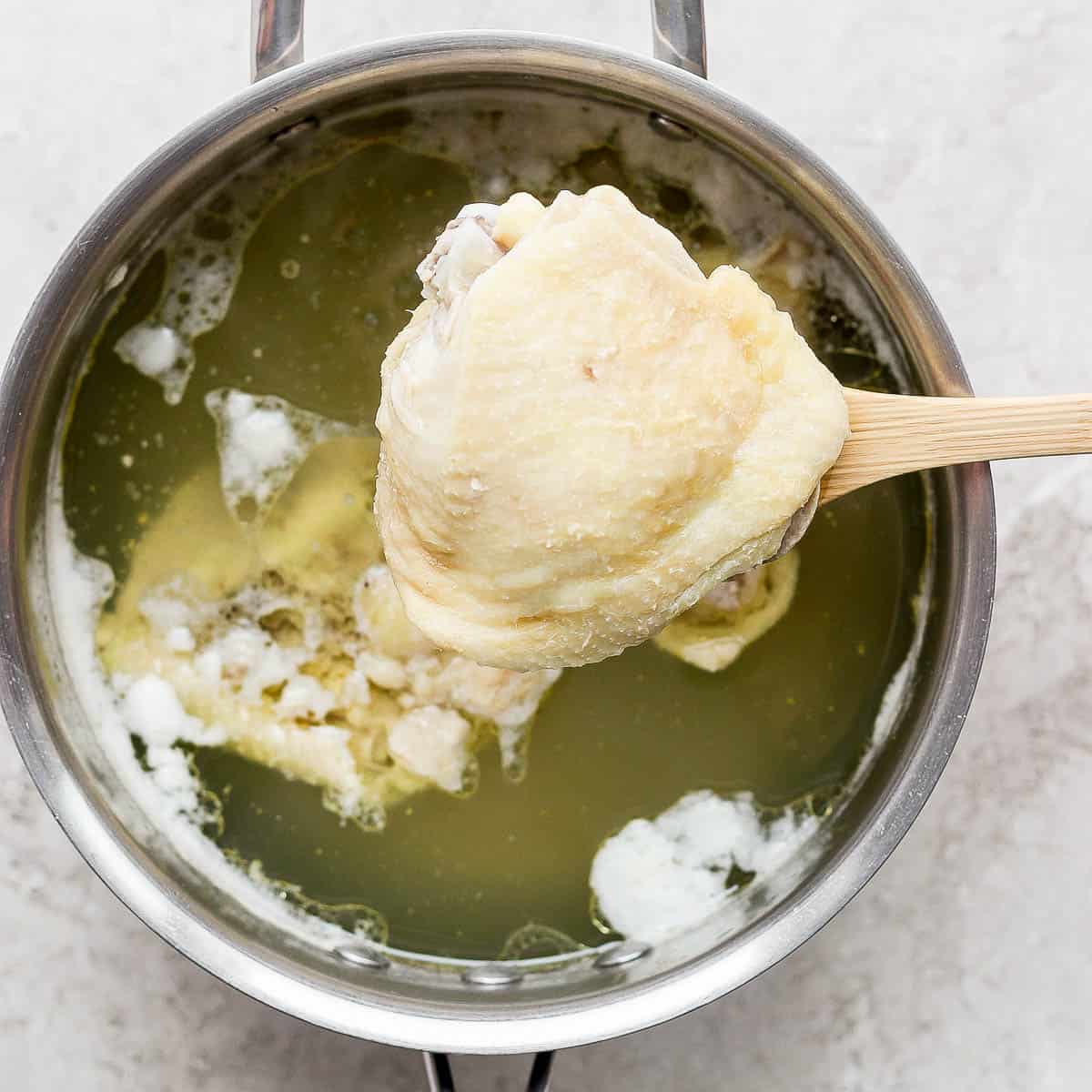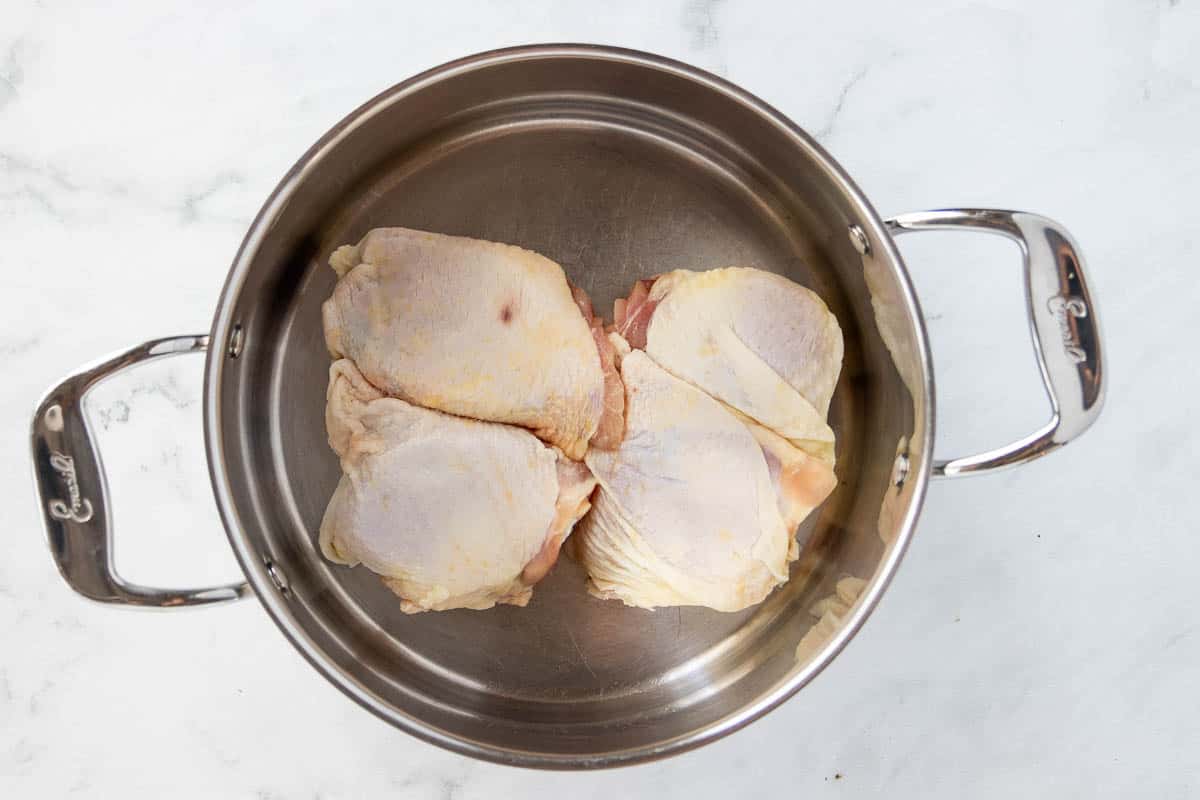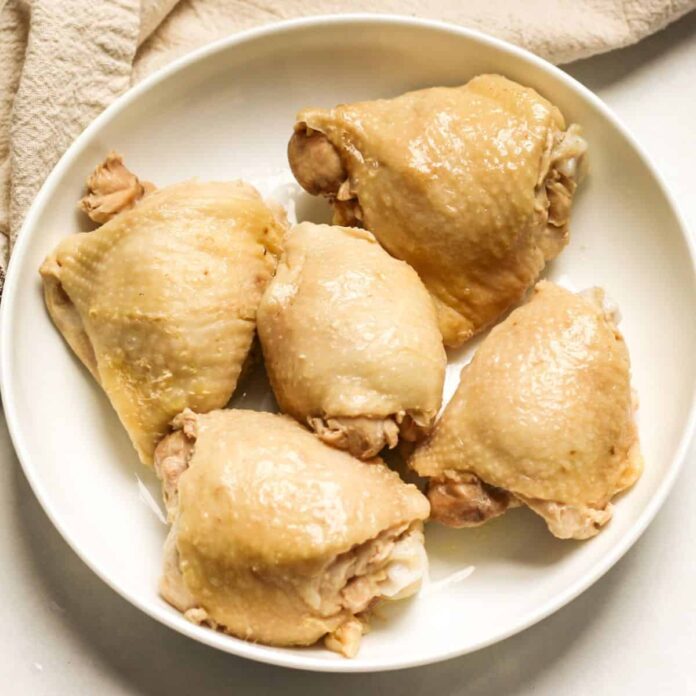How Long to Boil Chicken Thighs? Chicken thighs should be boiled for 25-30 minutes. Boiling is a simple and easy cooking method that ensures the chicken is cooked all the way through and is safe to eat.
To ensure your chicken thighs are fully cooked, use a meat thermometer to check the internal temperature, which should be 165°F (74°C). Boiling chicken thighs is a great option when you want a quick and easy meal. Not only is it a healthy cooking method, but it is also a versatile ingredient that can be used in a variety of dishes, such as soups, stews, salads, and more.
Boiling chicken thighs is a simple process that requires minimal effort and time. We’ll cover everything you need to know about boiling chicken thighs, including how long to boil them, tips for seasoning, and how to check if they’re fully cooked. So, let’s get started!

Credit: thewoodenskillet.com
The Basics Of Boiling Chicken Thighs
Boiling chicken thighs is a simple and efficient cooking method that can result in tender and juicy meat. Whether you’re making chicken soup, preparing shredded chicken for tacos, or just want a quick and easy protein option, boiling chicken thighs is a versatile technique to have in your culinary repertoire. In this article, we will explore the ideal cooking times and water temperature and preparation for perfectly boiled chicken thighs.
Ideal Cooking Times
When it comes to boiling chicken thighs, it’s essential to cook them for the right amount of time to ensure they are fully cooked and safe to eat. The cooking time will vary depending on the size and thickness of the thighs, but as a general guideline, you should boil chicken thighs for approximately 25-30 minutes.
It’s important to note that the chicken thighs should reach an internal temperature of 165°F (74°C) to guarantee they are fully cooked. To check the temperature, you can use a meat thermometer inserted into the thickest part of the thigh. If you don’t have a meat thermometer, you can also make a small cut in the thickest part of the thigh to ensure there is no pink or raw meat.
Water Temperature And Preparation
The water temperature and preparation are crucial factors that can affect the outcome of your boiled chicken thighs. Here are some key points to keep in mind:
- Start with cold water: Always begin by placing the chicken thighs in a pot filled with cold water. This ensures even cooking and helps retain the natural flavors of the meat.
- Bring to a gentle boil: Once the chicken thighs are in the pot, gradually increase the heat until the water reaches a gentle boil. Avoid boiling the water vigorously, as this can cause the meat to become tough and dry.
- Add seasonings: To enhance the flavor of the chicken thighs, you can add various seasonings to the water. Common options include salt, pepper, garlic, onion, herbs, and spices. Experiment with different combinations to create a taste that suits your preferences.
- Skim off impurities: As the chicken thighs boil, you may notice foam or impurities rising to the surface. Skim off these impurities with a slotted spoon or skimmer to maintain a clear broth.
- Simmer gently: Once the water reaches a gentle boil, reduce the heat to low and let the chicken thighs simmer. This slow and steady simmering process will help ensure the meat cooks evenly and retains its tenderness.
By following these guidelines for water temperature and preparation, you can achieve perfectly boiled chicken thighs that are flavorful and moist. Remember to adjust the cooking times based on the size and thickness of the thighs and always check for an internal temperature of 165°F (74°C) to guarantee their doneness.

Credit: www.createkidsclub.com
Selecting Chicken Thighs For Boiling
When boiling chicken thighs, it’s important to choose the right type of thighs to ensure the best results. Let’s explore the key considerations when selecting chicken thighs for boiling.
Fresh Vs. Frozen
Fresh chicken thighs are ideal for boiling as they have a better texture and flavor compared to frozen ones. The natural moisture in fresh chicken thighs enhances the boiling process, resulting in tender and juicy meat. On the other hand, frozen chicken thighs may require a longer boiling time and can sometimes become waterlogged, affecting the overall taste and texture.
Bone-in Vs. Boneless
Bone-in chicken thighs are excellent for boiling as the bones add flavor and richness to the broth. Additionally, the bones help the meat maintain its juiciness and tenderness during the boiling process. On the contrary, boneless chicken thighs are convenient and cook relatively faster, but they may lack the depth of flavor and succulence that bone-in thighs offer.
Preparation Before Boiling
Before boiling chicken thighs, ensure to season well for flavor. Boil for 30-40 minutes until fully cooked.
Cleaning And Seasoning
Before boiling chicken thighs, it is important to properly clean and season them. Cleaning the chicken helps remove any dirt or residue that may be present on the surface. Start by rinsing the chicken thighs under cold water, making sure to remove any excess fat or skin. Pat them dry with paper towels to remove any moisture.
Once the chicken thighs are clean, it’s time to season them. Seasoning adds flavor to the chicken and enhances its taste. You can use a variety of spices and herbs to season the chicken. Some popular options include salt, pepper, garlic powder, onion powder, paprika, and thyme. You can also experiment with different flavors by using spices like cumin, chili powder, or curry powder.
Herbs And Spices For Enhanced Flavor
Adding herbs and spices to your chicken thighs can take their flavor to the next level. Here are some herbs and spices you can use to enhance the taste of your boiled chicken thighs: 1. Rosemary: This herb adds a fragrant and earthy flavor to the chicken. 2. Basil: Known for its sweet and slightly peppery taste, basil complements the chicken well. 3. Oregano: With its robust and slightly bitter flavor, oregano adds depth to the chicken’s taste. 4. Thyme: This herb has a subtle and earthy flavor that pairs well with chicken. 5. Bay leaves:
Adding a few bay leaves to the boiling water infuses the chicken with a unique aroma. In addition to herbs, you can also use spices to enhance the flavor of your chicken thighs. Some popular choices include: 1. Cayenne pepper: If you like a bit of heat, adding a pinch of cayenne pepper can give your chicken thighs a spicy kick. 2. Smoked paprika: This spice adds a smoky and slightly sweet flavor to the chicken. 3. Cumin: Known for its warm and earthy taste, cumin can add depth to the chicken’s flavor profile. 4. Ginger: Adding a small amount of ginger can give your chicken thighs a subtle and refreshing taste.
Remember, the amount of herbs and spices you use will depend on your personal preference. Feel free to experiment with different combinations to find the flavors that you enjoy the most.

Credit: temeculablogs.com
Boiling Techniques
When it comes to boiling chicken thighs, mastering the right boiling technique is essential for juicy, tender results. Understanding the different methods such as simmering vs. rolling boil and covered vs. uncovered cooking can make a significant difference in the outcome of your boiled chicken thighs.
Simmering Vs. Rolling Boil
Simmering involves maintaining a gentle, steady heat just below the boiling point, while a rolling boil is characterized by vigorous bubbling and constant motion in the liquid.
Covered Vs. Uncovered Cooking
Covering the pot during boiling can help retain moisture and flavor, while uncovering it allows for reduction and concentration of flavors. The choice between covered and uncovered cooking can impact the texture and taste of the chicken thighs.
Testing For Doneness
To determine if chicken thighs are boiled long enough, check their internal temperature using a meat thermometer. The safe internal temperature for chicken is 165°F (74°C). This ensures the chicken is fully cooked and safe to eat.
Internal Temperature Guide
When it comes to testing the doneness of chicken thighs, one of the most reliable methods is to check the internal temperature. This ensures that the chicken is cooked thoroughly and safe to eat. To do this, you will need a meat thermometer. Here is a guide to the recommended internal temperatures for chicken thighs: – Boneless chicken thighs: The internal temperature should reach 165°F (74°C). – Bone-in chicken thighs: The internal temperature should also reach 165°F (74°C).
Remember to insert the thermometer into the thickest part of the thigh without touching the bone, as this can give an inaccurate reading. By using the internal temperature guide, you can be confident that your chicken thighs are cooked to perfection.
Visual And Texture Cues
If you don’t have a meat thermometer or prefer to rely on visual and texture cues, there are a few signs to look out for to determine if your chicken thighs are done cooking. These cues can help you achieve the desired level of doneness: 1. Color: Cooked chicken thighs should have an internal color of white or light pink, with no traces of pink or rawness. The juices should run clear, not pink or bloody. 2. Texture: When you press on the chicken thighs with a fork or your finger, the meat should feel firm and springy.
It should not feel rubbery or squishy, which would indicate that it is undercooked. 3. Bone mobility: If you are cooking bone-in chicken thighs, the bones should move easily when you twist or wiggle them. This indicates that the meat is cooked and has pulled away from the bone. By paying attention to these visual and texture cues, you can determine the doneness of your chicken thighs without relying solely on a meat thermometer. However, using a thermometer is the most accurate way to ensure safe and perfectly cooked chicken.
Serving Suggestions
To achieve tender and juicy chicken thighs, boil them for 30-40 minutes. Serve the boiled chicken thighs with a side of vegetables or a fresh salad for a wholesome and satisfying meal. Add your favorite seasonings or sauces to enhance the flavor.
Pairing With Sides
When serving boiled chicken thighs, it’s important to pair them with complementary sides to create a well-rounded and satisfying meal. Here are some popular options for pairing with chicken thighs:
- Steamed vegetables: Broccoli, carrots, and green beans are excellent choices.
- Mashed potatoes: Creamy mashed potatoes are a classic side dish that pairs well with chicken.
- Salad: A fresh garden salad with a light vinaigrette dressing can provide a refreshing contrast to the richness of the chicken.
- Rice: Whether it’s white rice, brown rice, or wild rice, it can serve as a versatile and filling accompaniment.
Creative Serving Ideas
Transforming a simple boiled chicken thigh into an exciting and visually appealing dish can elevate the dining experience. Consider these creative serving ideas:
- Stir-fry: Incorporate the boiled chicken thighs into a colorful and vibrant stir-fry with an assortment of vegetables.
- Tacos: Shred the chicken and use it as a flavorful filling for tacos, topped with fresh salsa and avocado.
- Sandwiches: Slice the chicken and create delicious sandwiches with your favorite condiments and fresh bread.
- Rice bowls: Build nourishing rice bowls with the chicken, assorted veggies, and a drizzle of savory sauce.
Safety Tips
Boiling chicken thighs is a common cooking method, but it’s important to ensure they are fully cooked to avoid any potential foodborne illnesses. Follow these safety tips to determine how long to boil chicken thighs and enjoy a delicious and safe meal.
Avoiding Cross-contamination
Use separate cutting boards for chicken and other foods.
Wash hands after handling raw chicken.
Clean countertops and utensils with hot, soapy water.
Proper Storage
Refrigerate raw chicken at 40°F or below.
Use airtight containers to prevent leaks.
Store cooked chicken for up to 4 days in the fridge.
Making The Most Of Leftovers
Wondering what to do with leftover chicken thighs? Don’t let those delicious pieces go to waste! Here are some creative ways to make the most of your cooked chicken:
Storing Cooked Chicken
- Refrigerate in airtight containers for up to 4 days
- Freeze for longer storage up to 3 months
- Label containers with date for easy tracking
Recipe Ideas For Leftover Chicken Thighs
- Chicken Salad: Mix with mayo, celery, and seasonings
- Chicken Tacos: Fill tortillas with shredded chicken
- Chicken Soup: Simmer in broth with veggies for a comforting meal
Frequently Asked Questions
How Long Should You Boil Chicken Thighs?
Chicken thighs should be boiled for about 30-40 minutes or until the internal temperature reaches 165°F. Make sure to remove any excess fat before boiling to avoid a greasy taste.
Can You Overcook Chicken Thighs By Boiling Them?
Yes, overcooking chicken thighs can result in a tough, dry texture. It’s important to use a meat thermometer to ensure the internal temperature reaches 165°F and to not boil the chicken for too long.
How Do You Know When Chicken Thighs Are Fully Cooked?
The best way to know if chicken thighs are fully cooked is by using a meat thermometer and checking that the internal temperature has reached 165°F. The chicken should also appear white and the juices should run clear when pierced with a fork.
Can I Add Spices While Boiling Chicken Thighs?
Yes, you can add spices such as salt, pepper, garlic powder, and onion powder to the water while boiling chicken thighs to enhance the flavor. You can also add vegetables like carrots and celery for extra flavor.
Conclusion
Knowing how long to boil chicken thighs is essential for delicious meals. Follow the guidelines to ensure perfect results every time. Experiment with flavors and cooking techniques to create a variety of tasty dishes. Mastering this skill will elevate your culinary expertise and impress your guests.
Happy cooking!


